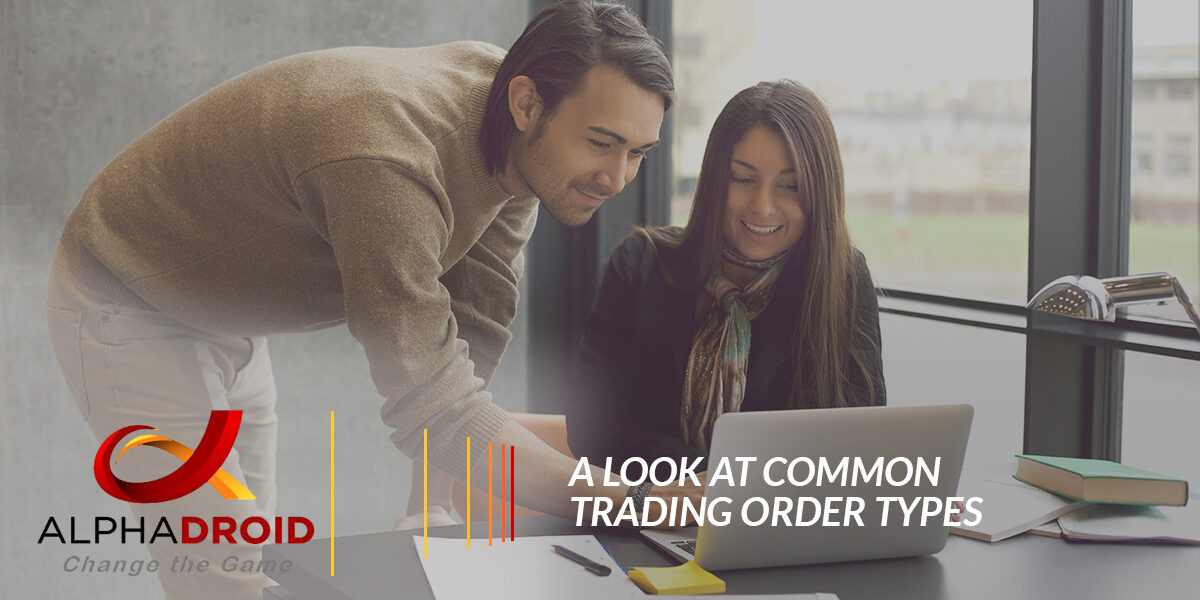A Look At Common Trading Order Types

Trading is much more than just buying and selling, it’s far more complicated than that. As algorithmic trading technology has helped close the knowledge gap between retail traders and large financial institutions, it has become easier for retail traders to use more advanced strategies in their trading. One of the ways investors and traders use these advanced strategies is the utilization of different order types.
There are many ways you can buy and sell using different order types — each serving its own purpose. In this blog, we are going to review seven of the most common trading order types, and when you will want to use them.
1. Market Order
A market order is one of the simplest, most intuitive order types. Market orders can be both bought and sold. A market order gives you gives you the best available price for a trade in the marketplace. For instance, if you purchase a stock using a market order, you will be the best available price from those willing to sell. However, if you sell using a market order, you whatever price is available from people willing to buy. Perhaps, the biggest advantage of a market order is speed. If you to get into or out of a trade quickly — such as when the price is quickly moving — a market order is one of the best options. However, the disadvantage with market orders is the price. You won’t necessarily know what price you are buying and selling at. Depending on the size of the order and the number of available shares at asking price, your order may not get the exact price you were hoping for.
2. Buy Limit Order
A Buy Limit Order is an order that is placed below the current price. It either is filled at or below the limit price, never above. This helps ensure that negative slippage never occurs. The buyer is safe from getting a worse price than expected. Buy limit orders enable investors and traders with a means of precisely entering a position. For example, a buy limit order can be put in for $3.50 when a stock is trading at $3.55. If the price drops to $3.50, the order is automatically executed. Buy Limit Orders have the advantage of purchasing stocks at the lower bid price and avoiding the spread — as the market trades downward toward the limit price, the trade is executed when the limit price becomes the inside bid. However, limit orders do not guarantee execution. This occurs when the market price trades down to the limit price, whether buying or selling, and immediately turns around and trades right back up.
3. Sell Limit Order
A Sell Limit Order is an order to sell that is placed above the current price. The order is only filled at or above the current price, never below. A Sell Limit Order is not guaranteed to execute and it can only be filled if the stock’s market price reaches the limit price. While these orders do not guarantee execution, they help ensure that an investor does not pay more than a predetermined price for a stock.
4. Buy Stop Orders
A Buy Stop Order is an order that is placed above the current market price. The order is only filled at or above the stopping price, never below. Many traders use this order to get out of a short trade. Therefore, they are beneficial when they are used as a stop loss on short positions when you need to get out due to the price moving against you. They are also helpful when it comes to buying breakouts above resistance, but you can’t be sure of the exact price you will end up buying at. This helps protect against a rise in share price by placing a buy stop order to cover the short position at a price that limits losses.
5. Sell Stop Order
A Sell Stop Order is an order to sell that is placed below the current price. The order will only be filled at or below the stop price, never above. These orders act like market orders once the sell stop price is reached, and many investors use this order to get out of a long trade, when the price is moving against them. Additionally, investors use these orders for selling on on breakouts below market trend, however, they cannot be sure of the exact price that they will be selling at.
6. Buy Stop Limit Order
A Buy Stop Limit Order is similar to a Buy Stop Order, except that it does not act like a market order. The buy stop limit will only fill at the buy stop limit price or lower, never above it. If an investor wants to buy as prices rise, this order helps prevent paying more than expected, protection that is not offered by Buy Stop Orders. Many investors use these orders when the price breaks above a particular level, such a resistance, but you only want to buy at a specific price (or lower) when that event occurs.
7. Sell Stop Limit Order
A Sell Stop Limit Order is very similar to a Sell Stop order, however, it doesn’t act like a market order. The sell stop limit will only fill at the price equivalent to the limit price attached to the order, or higher. Sell Stop Limit Orders set a command to sell a security if a specific price is reached, as long as the price doesn’t drop below the limit set by the investor or trader. When the security reaches the stop price, the order is switched to a limit order, which is executed at the specified limit price or better. If an investor wants to sell as the price falls, they can use a sell stop limit order to prevent selling at a lower price than anticipated.
A sell stop limit order is useful for selling when the price breaks below a particular level, however, you only want to sell at a specific price or higher when events like this occur.
8. Conditional Order
A Conditional Order is used by a variety of traders and investors. A conditional order is appropriate when it is important to automate part or all of the trade entry/exit order entry process. Conditional orders are advanced trading orders that are automatically submitted or canceled if specified criteria are met. Conditional orders must be placed before the trade is entered, and are considered the most basic form of trade automation.
There are additional order types that can be used to make trading strategies more advanced and understand them all and how they work can be a challenge. Using the wrong order type when your money is on the like can create issues. The best way to get used to these order types is to practice using them. With AlphaDroids award-winning investment portfolio management software, traders and investors are equipped with a variety of options for order entry. Our investment portfolio management software can help limit risk, speed execution, provide price improvement, allow privacy and time the market, and simplify the trading process through advanced algorithmic trading functions. To learn more about AlphaDroid, visit our site today!

